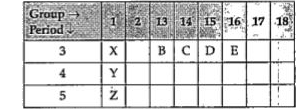The atomic numbers of three elements X, Y and Z are 3, 11 and 17, respectively. State giving reason which two elements will show similar chemical properties.
To determine which two elements among X, Y, and Z will show similar chemical properties, we first need to identify the elements based on their atomic numbers and then analyze their electronic configurations.
Step 1: Identify the Elements
- Element X has an atomic number of 3.
- Element Y has an atomic number of 11.
- Element Z has an atomic number of 17.
From the periodic table:
- Element X (atomic number 3) is Lithium (Li).
- Element Y (atomic number 11) is Sodium (Na).
- Element Z (atomic number 17) is Chlorine (Cl).
Step 2: Determine the Electronic Configurations
Next, we find the electronic configurations of these elements:
- Lithium (Li): The atomic number is 3, so its electronic configuration is 1s22s1.
- Sodium (Na): The atomic number is 11, so its electronic configuration is 1s22s22p63s1.
- Chlorine (Cl): The atomic number is 17, so its electronic configuration is 1s22s22p63s23p5.
Step 3: Analyze the Valence Electrons
The chemical properties of an element are largely determined by its valence electrons:
- Lithium (Li) has 1 valence electron in the 2nd shell.
- Sodium (Na) has 1 valence electron in the 3rd shell.
- Chlorine (Cl) has 7 valence electrons in the 3rd shell.
Step 4: Compare Chemical Properties
Elements that have the same number of valence electrons typically exhibit similar chemical properties. In this case:
- Lithium (Li) and Sodium (Na) both have 1 valence electron. Therefore, they are both alkali metals and will show similar chemical properties.
- Chlorine (Cl) has 7 valence electrons and belongs to a different group (halogens), thus it will not show similar properties to Li and Na.
Conclusion
The two elements that will show similar chemical properties are Lithium (Li) and Sodium (Na) because they both have 1 valence electron.
- Element X has an atomic number of 3.
- Element Y has an atomic number of 11.
- Element Z has an atomic number of 17.
- Element X (atomic number 3) is Lithium (Li).
- Element Y (atomic number 11) is Sodium (Na).
- Element Z (atomic number 17) is Chlorine (Cl).
Next, we find the electronic configurations of these elements:
- Lithium (Li): The atomic number is 3, so its electronic configuration is 1s22s1.
- Sodium (Na): The atomic number is 11, so its electronic configuration is 1s22s22p63s1.
- Chlorine (Cl): The atomic number is 17, so its electronic configuration is 1s22s22p63s23p5.
The chemical properties of an element are largely determined by its valence electrons:
- Lithium (Li) has 1 valence electron in the 2nd shell.
- Sodium (Na) has 1 valence electron in the 3rd shell.
- Chlorine (Cl) has 7 valence electrons in the 3rd shell.
Elements that have the same number of valence electrons typically exhibit similar chemical properties. In this case:
- Lithium (Li) and Sodium (Na) both have 1 valence electron. Therefore, they are both alkali metals and will show similar chemical properties.
- Chlorine (Cl) has 7 valence electrons and belongs to a different group (halogens), thus it will not show similar properties to Li and Na.
The two elements that will show similar chemical properties are Lithium (Li) and Sodium (Na) because they both have 1 valence electron.
Topper's Solved these Questions
- PERIODIC CLASSIFICATION OF ELEMENTS BOOK - OSWAL PUBLICATIONCHAPTER - PERIODIC CLASSIFICATION OF ELEMENTS EXERCISE - NCERT CORNER (INTEXT CORNER)
16 Videos
- PERIODIC CLASSIFICATION OF ELEMENTS BOOK - OSWAL PUBLICATIONCHAPTER - PERIODIC CLASSIFICATION OF ELEMENTS EXERCISE - NCERT CORNER (EXERCISE QUESTIONS)
19 Videos
- PERIODIC CLASSIFICATION OF ELEMENTS BOOK - OSWAL PUBLICATIONCHAPTER - PERIODIC CLASSIFICATION OF ELEMENTS EXERCISE - SELF - ASSESSMENT - 1 ( OBJECTIVE TYPE QUESTIONS)
13 Videos
- OLYMPIAD 2019 - 20BOOK - OSWAL PUBLICATIONCHAPTER - OLYMPIAD 2019 - 20EXERCISE - CHEMISTRY QUESTIONS (Is Matter Around us Pure)
1 Videos
Similar Questions
The atomic numbers of three elements X, Y and Z are 9, 11 and 17 respectively. Which of these two elements will show similar characteristics and why ?
View SolutionThe atomic numbers of three elements A,B and C are given below:
Element Atomic
A3
B9
C11
Giving reasons state, which two elements will show similar chemical properties.
View Solution
Knowledge Check
The atomic numbers of the elements X, Y and Z are 2, 10 and 16, respectively. Identify the element which does not exist in monoatomic state.
AXBZCYDX and YThe atomic number of three elements A, B and C are 10 , 18 and 8 respectively . Identify the element which is chemically reactive ?
AABBCCDboth A and BThe atomic number of three elements A, B and C are 10 , 18 and 8 respectively . Identify the element which is chemically reactive ?
AABBCCDBoth a and B
The atomic numbers of three elements A, B and C are 11, 13 and 19 respectively. Explain which two of the elements will belong to the same group of the periodic table.
View SolutionThe atomic numbers of the three elements X,Y and Z are 2,6 and 10 respectively
(i) Which two elements belong to the same group?
(ii) Which two elements belong to the same period?
Given reasons for your choice.
View SolutionThere are three elements X, Y and Z. Their atomic numbers are 11, 18 and 19 respectively. Amongst X, Y and Z:
Which element is chemically inactive?
View Solution
Identify the elements which have similar chemical properties as the element X.
View SolutionThe atomic numbers of the elements X, Y and Z are 2, 10 and 16, respectively. Identify the element which does not exist in monoatomic state.
View Solution
